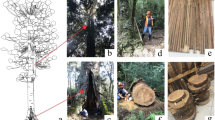Abstract
The aim of this study was to estimate a basal area growth model for individual trees in uneven-aged Caspian forests. A survey was conducted in order to find a natural forest without any harvesting activities, a so called ‘untouched forest’ and an area was selected from the Iranian Caspian forest. Three sample plots in the same aspect and of the same forest type were selected. In each plot, total tree height, diameter at breast height, distance of neighbor trees and azimuth were measured. Thirty trees were selected and drilled with increment borer to determine the increment model. Regression analysis was used to estimate the growth model. Results show that, for individual trees, there is a significant nonlinear relationship between the annual basal area increment, as the dependent variable, and the basal area. The results also show that the basal area of competing trees has a positive influence on growth. That the increment is higher with more competing neighboring trees is possibly because plots with higher volume per hectare and more competition, most likely also have higher site index or better soil or better site productivity than the plot with lower volume per hectare.







Similar content being viewed by others
References
Adame P, Hynynen J, Can˜ellas I, Rı’o M (2008) Individual-tree diameter growth model for rebollo oak (Quercus pyrenaica Willd.) coppices. J For Ecol Manag 255(3–4):1011–1022
Amanzadeh B (2015) Investigation on structure, natural stand development stages and ecological characteristics of canopy gaps in mixed stands of Nav Forests, Asalem. Sari Agricultural and Natural Resources University, Sari
Amini M, Namiranian M, Sagheb Talebi Kh, Amini R (2009) Investigation on the homogenity of diameter increment models in Fagus orientalis L. trees. J Wood For Sci Technol 16(4):1–23
Anonymous (2006) Forestry planning of district 3 of Nav Asalem, watershed number 7. Rangelands and Watershed Management Organization, Tehran
Attarod P (1999) Investigation and statically analysis of forest growth in two ecological using multivariate southern and northern aspects using multivariate statically method. University of Guilan, Guilan
Bayat M, Namiranian M, Zobeiri M, Fathi J (2014) Determining growth increment and density of trees in forest, using permanent sample plots (case study: gorazbon district of kheyroud forest). Iran J For Poplar Res 21(53):424–438
Cannell MGR, Rothery P, Ford ED (1984) Competition within stands of Picea sitchensis and Pinus contorta. J Ann Bot 53(3):349–362
Clutter JL, Fortson JC, Pienaar LV, Brister GH, Bailey RL (1983) Timber management: a quantitative approach. Wiley, New York, p 333
Coomes DA, Allen RB (2007) Effects of size, competition and altitude on tree growth. J Ecol 95(5):1084–1097
Heshmatol Vaezin SM, Attarod P, Bayramzadeh V (2008) Tree volume increment models of broadleaf species in the uneven-aged mixed Caspian forests. Asian J Plant Sci 7(8):700–709
Hosseini SM (2010) Forest operations management and timber products in the Hyrcanian forests of Iran. In: 43th international symposium on forestry mechanisation, Padova, Italy. July 2010
Lohmander P (2016) Optimal stochastic dynamic control of spatially distributed interdependent production units. In: International conference on mathematics and decision sciences, Guangzhou, China. September 2016
Lohmander P, Mohammadi Limaei S, Olsson L, Mohammadi Z (2016) Optimal forest management based on growth data from the Iranian Caspian forests. In: 9th international Iranian operations research conference, Shiraz University of Technology (IORC 2016) IORC, Shiraz, Iran. April 2016
Marvi Mohadjer MR (2005) Silviculture. Tehran University Press, Tehran, p 387
Mölder I, Leuschner C (2009) Diversity and tree neighbourhood effects on the growth dynamics of European beech and the stand seed bank in temperate broad-leaved forests of variable tree diversity. Georg-August-University Goettingen, Lower Saxony
Muller-Landau HC et al (2006) Comparing tropical forest tree size distributions with the predictions of metabolic ecology and equilibrium models. J Ecol Lett 9(5):589–602
Nguyen TT (2009) Modelling growth and yield of dipterocarp forests in Central Highlands of Vietnam. Technical University of Munich, Munich
Oladi R, Pourtahmasi K (2012) Intra-annual secondary growth rate-climate relations of Fagus orientalis Lipsky in the center of Hyrcanian forests. J Notulae Scientia Biologicae 4(2):136–140
Pereira da Silva R, dos Santos J, Siza Tribuzy E, Chambers JQ, Nakamura S, Higuchi N (2002) Diameter increment and growth patterns for individual tree growing in Central Amazon, Brazil. J For Ecol Manag 166(1–3):295–301
Pokharel B, Dech JP (2012) Mixed-effects basal area increment models for tree species in the boreal forest of Ontario, canada using an ecological land classification approach to incorporate site effects. J For 85(2):255–270
Rathbuna LC, Mayb VL, Smith N (2011) Diameter growth models for mixed-species stands of Coastal British Columbia including thinning and fertilization effects. J Ecol Model 222(14):2234–2248
Schutz JP (2006) Modelling the demographic sustainability of pure beech plenter forests in Eastern Germany. J Ann For Sci 63(1):93–100
Stadt KJ, Huston C, Coates DK, Feng Z, Dale MRT, Victor JL (2007) Evaluation of competition and light estimation indices for predicting diameter growth in mature boreal mixed forests. J Ann For Sci 64(5):477–490
Uzoh FCC, Oliver WW (2008) Individual tree diameter increment model for managed even-aged stands of ponderosa pine throughout the western United States using a multilevel linear mixed effects model. J For Ecol Manag 256(3):438–445
Wykoff WR (1990) A basal area increment model for individual conifers in the northern Rocky Mountains. For Sci 36(4):1077–1104
Yang Y, Watanabe M, Li F, Zhang J, Zhang W, Zhai J (2005) Factors affecting forest growth and possible effects of climate change in the Taihang Mountains, northern China. J For 79(1):135–147
Author information
Authors and Affiliations
Corresponding author
Additional information
Project funding: It was not any funding for this project as it was a part of a PhD thesis.
The online version is available at http://www.springerlink.com
Corresponding editor: Chai Ruihai.
Rights and permissions
About this article
Cite this article
Mohammadi, Z., Mohammadi Limaei, S., Lohmander, P. et al. Estimation of a basal area growth model for individual trees in uneven-aged Caspian mixed species forests. J. For. Res. 29, 1205–1214 (2018). https://doi.org/10.1007/s11676-017-0556-7
Received:
Accepted:
Published:
Issue Date:
DOI: https://doi.org/10.1007/s11676-017-0556-7




